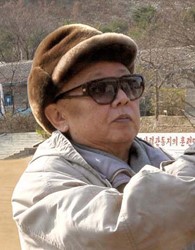Kim Jong Il assumed power a few years after his father suffered a heart attack. The dictator had a reputation as a somewhat erratic playboy, but his nuclear ambitions had to be taken seriously; he exploded a nuclear bomb in 2006.
Kim Jong Il’s Early Days
Kim Jong Il was born on February 16. North Korean officials claim that Kim was born in a log cabin on Mount Packtul, the highest point in Korea, and that a double rainbow marked his birth in 1942. Other records indicate he was born the year before in Siberia, where his father, Kim Il Sung, was stationed as a Soviet Army commander during World War II.
Much myth surrounds North Korea’s current head of state and at times it can be difficult to discern fact from fiction. It is known, however, that he lost his younger brother and mother, not long after the family returned to Korea. His father became the premier, and then the president of North Korea, and was referred to as the “Great Leader.”
Kim attended Kim Il Sung University in Pyongyang and wrote a thesis on his father’s agricultural policy. Although he revered his father, Kim often felt neglected by him, as Kim Il Sung had remarried and begun a new family.
For years, it was widely anticipated that his father would appoint his second son, Kim’s half brother, Kim Yong Ju, as successor. But in 1975, Kim was unexpectedly named the “party center,” at which point he became known as the country’s “Dear Leader.”
Immediately thereafter, Kim became culture czar, which allowed him to pursue his interests in film and opera. Soon afterwards, he was named General Secretary of the Workers’ Party and was elected in 1991 to succeed his father as commander of the country’s army, despite having no military training.
Read the state-endorsed biography of Kim Jong Il released in 1998 by North Korea’s Foreign Languages Publishing House. It includes only praise for Kim Jong Il and the North Korean government.
Sources in this Story
- Time: Kim Jong Il: Now It’s His Turn
- The BBC: Profile: Kim Jong-Il
- CNN: Mystery surrounds Kim Jong Il
- The New York Times: Times Topics: Kim Jong Il
- The New York Times: Kim Jong-il’s Heir Attends Parade
- Biography.com: Kim Jong Il
- CNN: Kim Jong Un Fast Facts
Kim Jong Il as Leader of North Korea
Three years after the death of his father in 1994, Kim completely took over the task of running of North Korea’s communist government, earning a reputation as an irrational and enigmatic dictator.
Since becoming the country’s leader, Kim has made nuclear development a priority for the country, going so far as to set off a nuclear bomb in 2006, which violated a 1994 agreement to halt nuclear activities.
North Korea’s level of censorship ranks as one of the highest in the world, and Kim maintains his shroud of mystery through strict control of the press. However, he garnered attention for his eccentric appearance, sporting a bouffant hairstyle and platform shoes to make himself seem taller. Reports suggest he had a passion for women, Hollywood movies and gourmet food and alcohol, although it is difficult to discern which elements of his persona are authentic and which are exaggerations.
Despite his quirks, some experts assert that Kim’s bizarre-seeming public image masks a quite rational leader According to CNN, “Kim’s persona seems to have been carefully cultivated to become a leader who has played a poor hand of cards skillfully.”
Although he periodically attempted to make peace with the West, Kim never fully committed to the process, often sporadically “reverting to the use of shrieking vitriol,” The New York Times reports.
Kim Jong Il Works
- “Kim Jong Il on the Art of Opera: Talk to Creative Workers in the Field of Art and Literature September 4–6, 1974,” by Kim Jong Il
- “Our Socialism Centered on the Masses Shall Not Perish,” by Kim Jong Il
- “The Ministry of Truth: Kim Jong-Il’s North Korea,” by Christian Kracht
- “Under the Loving Care of the Fatherly Leader: North Korea and the Kim Dynasty,” by Bradley K. Martin
The Rest of the Story
In August 2008, Kim Jong Il apparently suffered a stroke, an event that prompted speculation as to his choice for successor, although there were no immediate leads.
A 2009 South Korean news report indicated that Kim had named his youngest son, Kim Jong Un, to succeed him, and in the fall of 2010, Kim Jong Un was named a four-star general and appeared alongside his father during a parade.
Kim Jong Il died December 17, 2011, after reportedly having a heart attack, and Kim Jong Un assumed power.
This article was originally by Isabel Cowles; it was updated January 3, 2017.











